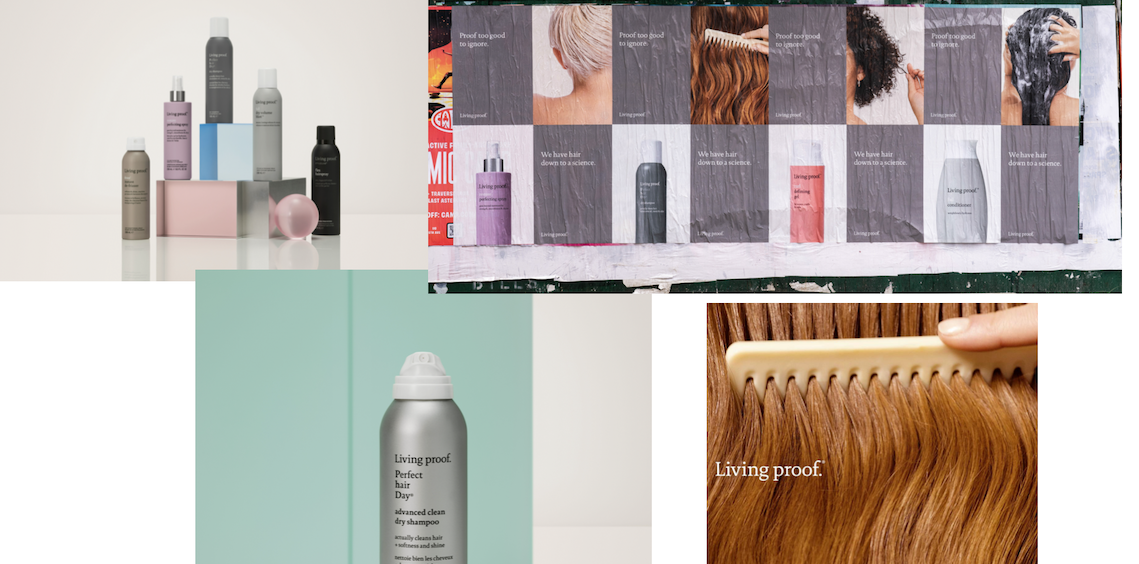Living Proof is trying to put both the “living” and “proof” back into the brand name.
On Monday, Living Proof kicked off a sweeping brand awareness campaign called “Science in Action.” It targets consumers via a mix of out-of-home billboards and wild postings, a TikTok campaign and YouTube ad videos, alongside traditional ads across Facebook, Instagram and podcasts. When Living Proof launched out of MIT in 2005, it was one of the earliest brands to emphasize its science- and tech-backed formulas. It was acquired by Unilever in 2016. Jennifer Aniston, the brand’s ambassador and an investor, left the brand following the acquisition.
According to previous Glossy reporting from March, Living Proof plans to grow to $200 million in annual revenue over the next four years, fueled by global expansion into Asia and the U.K. Historically, 85% of the brand’s sales have been from North America. Unilever did not disclose in 2016 how much it paid to acquire a 100% stake in Living Proof, but estimates at the time pointed to around $150 million. At the time, Living Proof was expected to earn $50 million in annual sales, according to Financial Times.
“The challenge was how to reinvigorate a brand that hasn’t lost customer love but has stopped gaining a new customer. [It went through a] bit of an identity crisis. It was acquired by Unilever, and Jennifer Aniston left shortly thereafter. While the DNA of the brand has stayed the same, we lost some of that spark, from a consumer perception level,” said Alexis Tedesco, Living Proof CMO, who joined the brand in March.
Tedesco said that her goal for Living Proof has been to galvanize and build up the brand’s online community. This has included adding more user-generated content to the brand’s social media by reposting unpaid celebrity and hairstylist advocacy. Additionally, the brand has increasingly emphasized the “proof” in Living Proof through before, during and after photos, among other tactics.
Tedesco added that her marketing budget was flat year-over-year from 2020 and 2021. So her team has pulled back from big product shoots, in order to focus on reposting UGC photos and videos. It’s also pulled back on Facebook and Instagram advertising, to reallocate those funds to TikTok and podcast advertising. Under Tedesco’s leadership, the brand’s social media engagement in the form of likes, comments and shared posts, has improved, growing 32% compared to 2019.
“It doesn’t feel like anything has replaced the heart of the brand, [since Jennifer Aniston],” said Danielle Chocron, managing director of creative agency Blonde & Co. “It feels functional and clean, and their messages are clear, but there’s some heart or authenticity is missing,”
Ad position: web_incontent_pos1
Julie Stahl, Blonde & Co. founder and CEO, added that it makes sense for Living Proof to lead with its science-led approach, but that even performance-focused brands need to foster an emotional connection. Backing corporate-social programs around young women in S.T.E.M. could be one such approach, she said.
“’Science in Action’ could go in a lot of places, and there are opportunities to tell a lot of stories,” she said.
Tedesco acknowledged that focusing exclusively on the science of the brand can, at times, be “boring and abstract,” and that there are now many other brands that also make science-backed claims. This conundrum led to the theme of “Science in Action” which is meant to explain in an easier way how Living Proof’s scientific claims around performance are experienced every day. To help execute this strategy, Living Proof tapped 10 TikTok influencers for a 1950s-style documentary video. A Trans-Atlantic accented voiceover details the science of Living Proof products.
“When you get compliments on your hair when you’ve done nothing different other than change up your routine to Living Proof, that’s science in action. When you cut your blow-dry time in half, that’s science in action,” said Tedesco. “Jennifer Aniston was the proof [of science in action] for so long, but now it’s about our community.”
The out-of-home portion of the campaign features 40 wild postings in the New York neighborhoods of SoHo, Tribeca, the West Village and the Lower East Side. New editorial assets were created for the brand’s static and video Facebook, Instagram and YouTube ads. According to Tedesco, Living Proof had not run out-of-home ads since before the Unilever acquisition and has not done a significant brand awareness campaign for at least three years.
Ad position: web_incontent_pos2
“There’s a huge interest from customers now to understand not just what’s in their product, but also how their products are working,” said Tedesco. “We’re poised for that conversation.”




